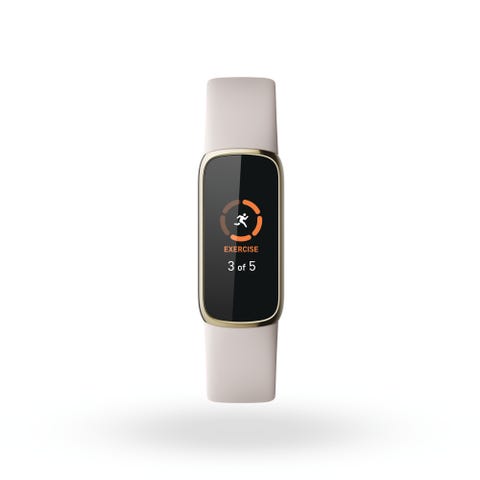The first wearable I ever tested, Fitbits Alta HR, was also the first time I tried a device that tried to balance fitness appeal with fashionable aesthetics. It was a tough balancing act in 2017, but I liked the slim tracker and its (for the time) ambitious touchscreen design.
Fast forward to 2021 and the latest version from the company, the emerging Luxe tracker. The new device seems to be accomplishing the same goal as the old one – bridging the gap between fitness technology and fashion – and Fitbit is doing well in many ways. The Luxe is as good as you won’t get with a simple fitness tracker, and with a variety of eye-catching accessories that don’t look out of place in combination with formal attire, you don’t have to take it off when you get dressed outside of the gym .
Fitbit
luxury
$ 150.00
The Luxe is so much smaller and lighter than the trackers and smartwatches I’ve got used to that testing felt like giving my wrist a breather. The tracker itself builds on the shape of the brand’s most basic device, the Inspire 2, with better materials. The Luxe has a stainless steel case with subtly rounded corners and has a slim touchscreen surface that remains a reflective ink black until you wake up. The metal case and screen capture the light like a piece of jewelry instead of sitting like a blank piece of plastic on your wrist when it’s not “awake”, a big plus. The total lack of buttons – even the novel inductive control points Fitbit uses in its Charge and Sense devices – was a great choice to keep the design seamless. That makes 24/7 sleep tracking wear much more palatable, a big problem many users have with larger, bulkier devices.
Fitbit wisely chose a comfortable silicone strap as the standard attachment, although there are several other ways to classify the tracker, from a stainless steel mesh option that I tried out for a couple of days as a change of pace, to leather and link bracelet accessories. These will cost you, but if you want to live up to the Luxe name, don’t be surprised to find you have to pay more than the base price.

Click here to join for more exclusive health and fitness content.
Men health
Using the Luxe is easy. The full-color touchscreen is bright and responsive, and it took me just a few tries to master the series of swipes and taps required to navigate the user interface. Thinking back to the times when I struggled to swipe and stab the Alta HR’s now primitive touchscreen, I now have to laugh as I slide my finger across the screen for a 2-minute relax-breathing session without starting a single wasted move.
I recorded a few workouts and runs with the Luxe. There are no surprises here if you’ve ever used a Fitbit device, and the barrier to entry is low if you’ve never done it before. The sleek design makes the Luxe much more functional than larger wearables for weight training – especially for workouts that involve wrist flexion exercises like pushups and presses – but tracking is pretty easy, even with over 20 workout modes available.

Fitbit
Serious runners will miss the built-in GPS found in higher spec devices (you’ll need your phone for GPS location with the Luxe nearby), but those type of athletes would probably be happier with a more traditional wearable anyway. The fashionable target group for whom the Luxe was developed would rather have a device record their steps, heart rate and the minutes of the active zone – Fitbit’s more elaborate measure that debuted with the Charge 4 and its devices via the status of a glorified pedometer – than obsessing over high-level performance data. That’s not to say the Luxe is a slacker in the data department, and Fitbit is offering six months of its premium service for free with every purchase, so wearers have access to personalized insights, coaching, and workouts to keep them busy.
I was most impressed by the Luxe’s battery. It sounds like a simple thing, but there are few features that are more important to a 24/7 wearable device. Fitbit advertises five days of no power on a single charge. I used the Luxe for a full week before I had to plug it back in for more juice. During this time, I followed several workouts and tested other features like the relaxation sessions and the use of timers and alarms. Performance can change over time, but this is a great place to start – especially if you think of the Luxe as a statement piece that you want to be a constant addition to your outfits.
Paying $ 150 for a basic fitness tracker can be a challenge, especially when the excellent Charge 4 comes for the same price with its built-in GPS and other premium workout features. So the key for Fitbit is to emphasize the aesthetics of the Luxe as well as its functionality. I liked having that touch of flair on my wrist while testing, and I think a sizable number of people who care about their looks as much as their health will agree. It may have taken Fitbit until 2021 to create a device that really effectively blends fashion and fitness, but the Luxe is proof of the concept that you can have both.
This content is created and maintained by a third party and imported onto this page to help users provide their email addresses. You may find more information on this and similar content at piano.io

